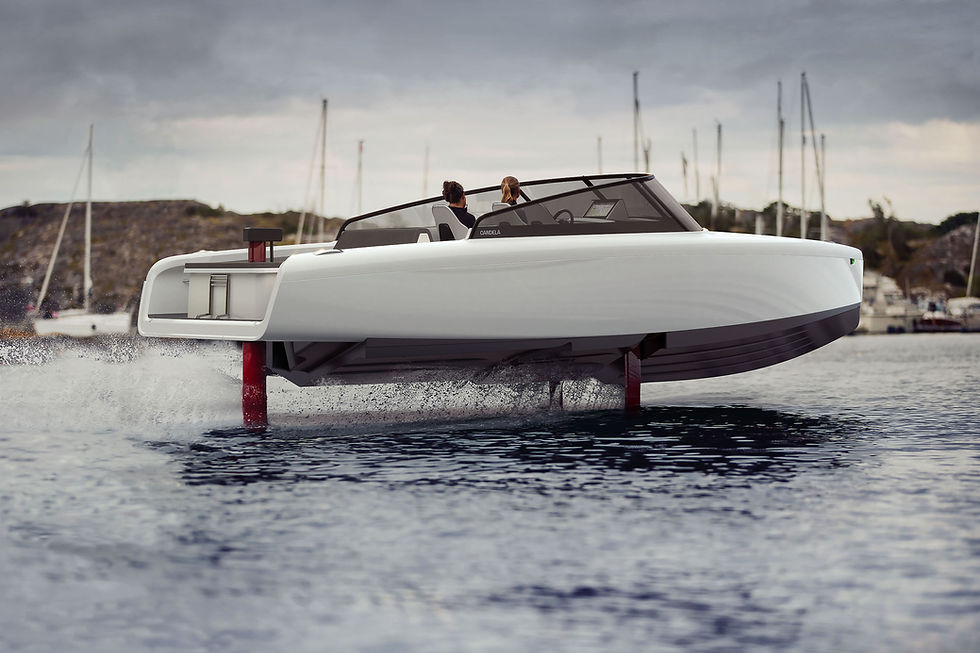Are We Finally Ready for the Hydrofoil Pleasure Boat Era?
- Bill Jennings

- Jan 25, 2023
- 6 min read
Updated: Jan 28, 2023

With recent advances in technology and performance, the signs are starting to point to 'yes.'
Most of us have watched the latest sailboats entered in America's Cup as they race along at spectacular speeds. You may have also noticed they use hydrofoils under their boat to achieve these speeds. But what exactly is a hydrofoil boat? Are they practical? Do they represent the future in boating? Let us discuss.
My first exposure to a hydrofoil boat was about 50 years ago when a Russian-built aluminum boat with foils was giving a demonstration on Lake Ontario, near Port Credit. The boat travelled back and forth, parallel to the shore, gradually increasing speed with each run. Suddenly, the boat appeared to lift and stuff into a wave, coming to an abrupt stop and taking on a large quantity of water. One of the passengers was seriously injured. Having witnessed this, I remained skeptical about the use of hydrofoils -- until now.
Boat builders have always known that water drag is a major consideration when designing an efficient watercraft. Drag created by water is said to be 800 times greater than the drag created by air. Try swinging your arm back and forth through the air in front of you. Now imagine standing in a swimming pool and swinging your arm underwater, through the same pattern. Over the years, boat designers have dealt with this in different ways. Most large boats push their way through the water, moving it to the side as they travel. These are displacement hulls. Today, most smaller pleasure boats have a combination of hull shape and sufficient horsepower to accelerate up out of the water and get on plane at much faster speeds. These are planing boats. With less of their hull in the water they have a reduced wetted surface, which translates to less drag.
So if boat performance is improved by having it ride higher in the water, why not raise it out of the water altogether? That was part of the thinking behind the development of hydrofoils. Underwater "wings" were experimented with as far back as 1869, with varying degrees of success. The hydrofoil concept has slowly expanded ever since. Before evaluating the pros and cons of foil boats, lets be sure we understand exactly how they work.
Air and water are governed by similar fluid equations, so an easy way to explain foil action is to compare their forces to aircraft wings. Hydrofoils are shaped with a slightly curved upper surface and a flatter lower surface. When water meets the leading edge of a foil, some water molecules split upwards and some split downwards. The water passing over the top of the wing travels downwards over the greater distance of the curved top surface versus the flatter bottom surface. This causes the water molecules over the top surface to travel faster. To put it more clearly, the water flow around the foil has a higher average velocity on the topside than on the bottom side. This difference in water molecule speeds creates a lower pressure stream on the top of the foil than the water travelling along the more direct route on the lower surface of the foil. The pressure difference creates a force on the foil that pulls it upwards in the water, thereby lifting the boat with it. At the same time there is a second force also acting to lift the foil. The water leaving the bottom of the curved foil is forced downward by the water exiting the top. Therefore, as per Isaac Newton's third law of motion, the downward water force creates an equal and opposite upward force on the foil pushing it upwards. These combined lifting forces on the foil eventually exceed the downward gravitational force of the boat and the boat lifts. The lifting continues until it reaches a point where the hydrofoil reaches its maximum designed lift potential. At that point, the upward force of the foil equals the downward gravitational force of the boat. With this balance of forces the boat is flying in equilibrium.
Interestingly, these same two forces apply to a powerboat propeller as it generates thrust and a sailboat sail as it moves a sailboat.
There are two general classifications for hydrofoils. The first is "surface piercing" partially submerged 'V' shaped foils. The second are known as "fully submerged' flat shaped foils. Flat foils are less subject to the effects of wave action, but usually need to be adjusted, either manually or by computer, to meet different sea conditions.
From a dead stop, the boat operates as a displacement hull until about 18 mph at which point the lift becomes effective. As you might expect, foil lift increases as the boat travels faster until it meets equilibrium. Top speeds will vary considerably depending upon the weight, length, and power of the boat. With today's modern designs, a top speed of 50 mph is not uncommon.
Adjustable foils are what permit such noteworthy speeds, but as foil adjustments exceed 13 degrees the foil can enter a "stall" just like an aircraft wing. This will happen when the water flowing over the top of the foil can no longer adhere to the surface and breaks into turbulence. There is no mistaking this when it occurs, as lift is suddenly lost.
After looking at some of the advantages to having a hydrofoil boat, you may want to go right out and buy one. Hydrofoil boats are known for speed. They are considerably faster than an equivalent sized boat with the same horsepower. Say goodbye to rough water discomfort. While your current boat runs along the surface of the water the hull on a hydrofoil does not touch the water, so there is no negative impact. The foil is the only part of the boat in the water, and it is running in the smooth water below the surface. Boat wakes that normally create a bumpy ride are totally smoothed out. A foil ride is not only smoother, it is dryer. A standard pleaseureboat in choppy water will slap water out to the side, and it can come back at passengers in the boat. Foils raise the height of a boat, where you are far less likely to experience spray.
Here is another big advantage: the reduced drag with a foil means that the fuel to distance ratio of a foil boat is maximized. This means you save on fuel, which is a major percentage of operating costs. Of course, when your fuel consumption decreases your boat's range also increases, allowing you to travel to those places that you did not dare to reach for previously.
With so many advantages to having a hydrofoil boat, we have to ask why every boater doesn't have one? Like every boat, foils also have some disadvantages. First of all, they are 'different.' Boaters do not like 'different.' Only when 20% of boaters get something new with their boat does it become accepted, but when a new design achieves that magic percentage suddenly the other 80% want the same thing. Hydrofoils have a long way to go before they represent 20% of boat sales.
Most of the manufacturers that I contacted cited premium costs as the number one reason for low hydrofoil sales. Much of this high cost is the research invested into foil design for each specific boat. Hopefully, the research costs will gradually come down as more foil boats enter the market. A second reason for higher foil prices is the additional materials required during manufacturing. While buyers will recoup some of their original cost through the efficiency of a hydrofoil, the current higher cost remains a major disadvantage.
Hydrofoil manufacturers admit that some foil boats can be more difficult to drive than a typical runabout. They are more difficult to steer and turn. This is never a good thing when it comes to recreational boating. And if conditions create an unequal lift, the operator must be able to feel this difference and make driving adjustments accordingly.
And lastly, an obvious disadvantage of foils is having these appendages under your boat when driving at a speed where you are not raised by the foil. In many waters you could find yourself in need of paying special attention to water depth. And when you are not "flying" on the foils, they are simply creating drag. While listing foil concerns I should also note that if you have hydrofoils beneath your boat you will also need a custom built trailer.
Considering these pros and cons of hydrofoils, could they really represent the next generation of pleasure boat? The answer is yes -- but not quite yet. Any boat that delivers more speed, a smoother ride, and improves fuel economy is worth considering, but today's boat manufacturers are all missing one important ingredient. Once hydrofoil manufacturers introduce this missing factor in their designs, many of the concerns with foils will be eliminated and they will come into vogue. I know what is needed and I am watching closely to see if and when builders introduce this necessary change.
In the meantime, water sports enthusiasts are able to enjoy a variety of hydrofoil toys that are readily available. A "hydrofoil waterski," is like a large waterski that you sit on. Some have an internal electric motor and some are towed. Their lift and ride top out at around 25 mph. Hydrofoil kiteboards" and "Hydrofoil windsurfers" have also added a new dimension to kiteboarding and windsurfing. The addition of the foil makes your ride smoother and faster as you move with the wind.
As people become more accustomed to boats and water sports toys that employ hydrofoils, their advantages will certainly make them popular. Within a few years we may see 20% of pleasure boats using foils on pleasure boats. That's when you will want one too. #culture


















Comments